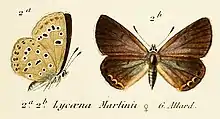Kretania martini
Kretania martini, or Martin's blue, is a species of North African butterfly in the family Lycaenidae and the subfamily Polyommatinae.
| Kretania martini | |
|---|---|
 | |
| Scientific classification | |
| Kingdom: | Animalia |
| Phylum: | Arthropoda |
| Class: | Insecta |
| Order: | Lepidoptera |
| Family: | Lycaenidae |
| Genus: | Kretania |
| Species: | K. martini |
| Binomial name | |
| Kretania martini (Allard, 1867) | |
| Synonyms | |
| |
Systematics
The species was first described by French entomologist Gaston Allard in 1867. He initially named the species Lycaena martini.[1][2] The type specimen was from Lambaesis, in Algeria.
The species was placed in the genus Plebejus, and the subgenus Plebejides,[3] but was later moved to the genus Kretania,[4] along with other species placed in Plebejides.
Subspecies
Several subspecies have been described.[5]
- Kretania martini martini (Allard, 1867) — from Algeria
- Kretania martini ungemachi (Rothschild, 1926) — from the High Atlas and the Middle Atlas mountains of Morocco
- Kretania martini mgouna (Tarrier, 2002) — from the M'Goun mountain in Morocco
- Kretania martini regularis (Tennent, 1995) — from the Rif region of Morocco
Description
The imago of the species is a small butterfly which is sexually dimorphic. The top of the male is blue purple with a thin black border and a white fringe, while that of the female is dark brown with a blue basal suffusion, white fringe, and a series of orange submarginal half moons and black marginal spots on the hindwings.
The underside of the wings is beige gray decorated with black spots circled in white, with a series of orange submarginal half moons bordered by black and white chevrons, and a series of black marginal spots.
The ornamentation resembles a similar species, Kretania allardii.[3]
Biology
Host plants
Plants that host the species include Astragalus massiliensis and Acanthyllis numidia for K. m. martini, Astragalus incanus incurvus for K. m. ungemachi and Astragalus armatus for K. m. regularis. Astragalus alopecuroides and Astragalus nemorosus also host the species. The catepillars exist in myrmecophily with ants from the genus Crematogaster.[6]
Distribution
The species is present in Northern Africa, specifically Morocco and in northern Algeria.[3][6]
It prefers fairly dry and flowery open environments, generally between 1,000 and 2,100 m above sea level.[3]
Conservation
In Morocco, the subspecies Kretania martini ungemachi is considered vulnerable, and the subspecies K. m. regularis and K. m. mgouna endangered.[5]
References
- Allard, G. (1867). "Notes sur les insectes de l'Algérie". Annales de la Société Entomologique de France. 7 (4): 314, 319.
- Savela, Markku (November 23, 2018). "Kretania martini (Allard, 1867)". Lepidoptera and Some Other Life Forms. Retrieved June 8, 2020.
- De Prins, van der Poorten & Bálint 1992.
- Talavera, Gerard (2013). "Establishing criteria for higher-level classification using molecular data: the systematics of Polyommatus blue butterflies (Lepidoptera, Lycaenidae)". Cladistics. 29 (2): 166–192. doi:10.1111/j.1096-0031.2012.00421.x.
- Les Rhopalocères du Parc Naturel d'Ifrane.
- (Tolman & Lewington 1997)
Further reading
- Tolman, Tom; Lewington, Richard (1997). Guide des papillons d'Europe et d'Afrique du Nord. Delachaux et Niestlé. ISBN 978-2-603-01649-7..
- De Prins, Willy; van der Poorten, Dirk; Bálint, Zsolt (1992). "Taxonomic revision of the North African species of the genus Plebejus Kluk, 1802 (Lepidoptera : Lycaenidae)" (PDF). Phegea. 20 (1): 11–34..